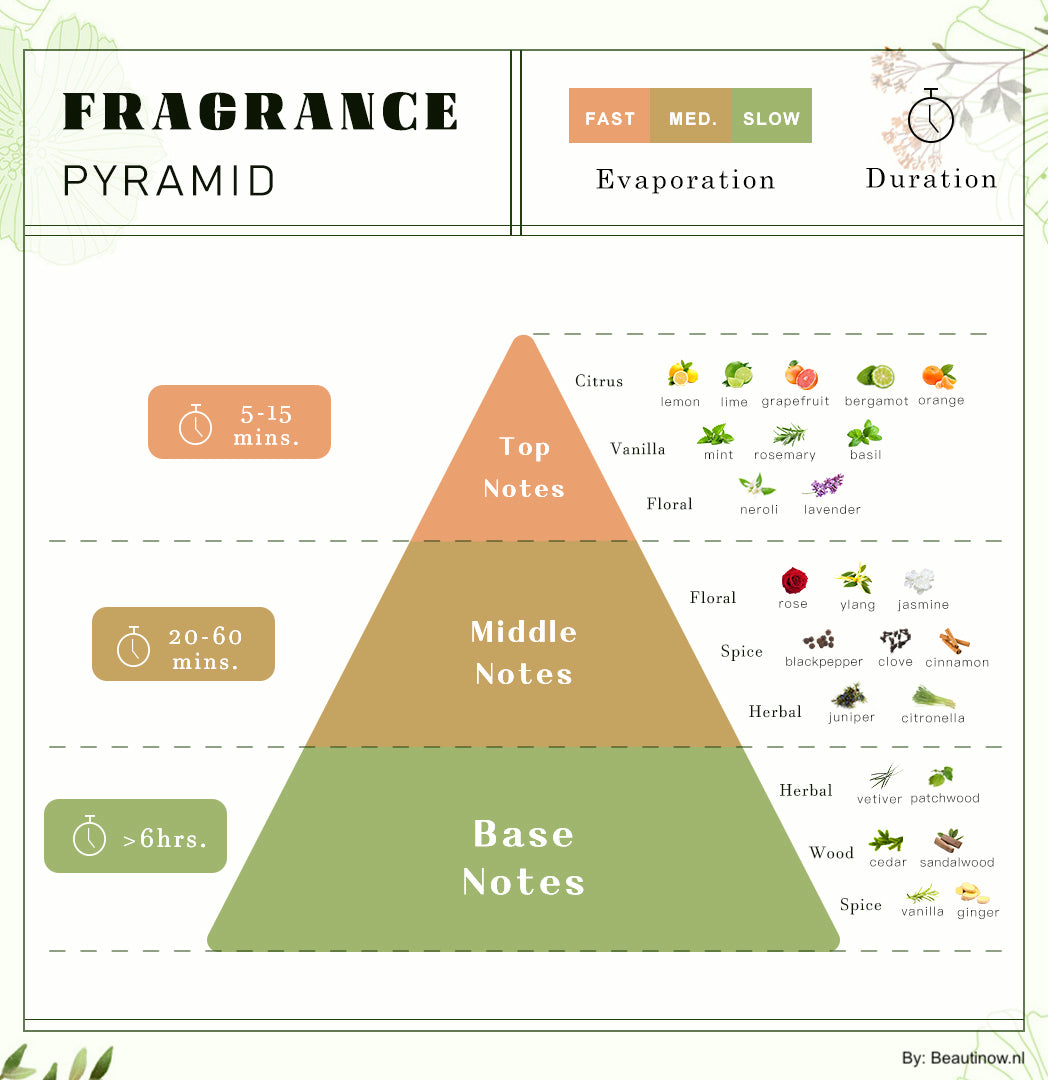Perfume Olfactory Pyramid: Perfume Notes Explained

Creating a perfume involves many intricate procedures to ensure that the composition and balance of the fragrance are just right. A thorough knowledge of fragrance notes and their topology is essential for perfecting scent compositions that please the senses. Each perfume ingredient has its own special molecular properties as a result of which it assumes a specific role in an olfactory composition. The olfactory pyramid is one of the most well-renowned ways to visualize a fragrance’s recipe and life-cycle.
What are perfume (fragrance) notes?
Perfumes are in essence a fusion of many different chemical compounds. Both synthetic and natural ingredients are utilized to create a balanced and delightful fragrance. Most perfumers do not disclose the exact, formulaic composition of a perfume, but they do present a breakdown of the identifiable smells that can be detected by wearers. The term ‘notes’ is used to refer to these ingredients with familiar scents, and they fuse to create scent accords. It is important to note that the notes of a perfume are not literal chemical ingredients, but simply aromatic placeholders for the same. Top notes, heart notes, and base notes make up the olfactory pyramid of any fragrance.
What Are Top Notes?
The top notes of a perfume, placed at the peak of the pyramid, tend to be the most memorable and vivid for any wearer. They constitute the immediate whiff one gets upon spraying a perfume which means that they are instrumental in forming one’s first impression of any perfume. However, they also happen to be the most volatile, so they evaporate the quickest. Since they have lighter, smaller molecules, they bounce off the skin after imparting a strong burst of fragrance. They last for the first 5 to 15 minutes after spraying a perfume. However, the importance of the top notes is undeniable because they help orchestrate a memorable transition into the second layer, consisting of the heart notes.
What Are Heart Notes?
The middle or heart notes come out to play once the top notes have evaporated and stay for around 20 minutes to a full hour. Often termed the “soul” of the perfume, these middle notes create a perfect bridge between the other layers of the perfume and makeup about two-thirds of the composition, ensuring that there is no jagged edge to the composition. They tend to constitute the personality of a fragrance and are evident in the evolution of the scent even after evaporation. One of the more functional aspects of heart notes is that they help suppress the base notes until they are mature enough to emerge and complement the fragrance. They hold on to the remnants of the top notes and slowly introduce the base notes so that the wearer does not have a jarring experience.
Heart notes often consist of rich, aromatic floral oils such as jasmine, geranium, neroli, and ylang-ylang. They may also include spices and herbs like cinnamon, pepper, pine, lemongrass, black pepper, and cardamom.
What Are Base Notes?
The base notes might sound trivial, but they are responsible for holding the perfume scent together once the top and middle notes evaporate. Once the middle notes seep into the base notes, they mature enough to emerge and add depth to the perfume. The foundation of every perfume is based on its assortment of base notes because this layer lasts the longest in the fragrance life cycle, 5-6 hours at the very least. These notes start peeking in slowly while the middle notes are evident and then carry the scent forward by creating unique accords. They tend to be rich, heavy, and grounded so that the scent can hold on to your skin longer.
Popular base notes include vanilla, amber, musk, patchouli, moss, and woody notes like sandalwood and cedarwood.
How Do You Identify Perfume Notes?
Identifying perfume notes is an art that enhances your sensory experience with fragrances, allowing you to appreciate the complexity and craftsmanship behind each scent. To begin, apply a small amount of perfume and pay attention to the initial scents; these are your top notes, often fresh and vibrant, like citrus or herbal fragrances. As the fragrance settles, middle notes emerge—these are the heart of the perfume, characterized by floral or fruity scents. Finally, base notes, which are deeper, like musk or vanilla, reveal themselves, providing a lasting impression of the perfume. Training your nose by experiencing a wide range of scents and referring to fragrance descriptions can further refine your ability to identify these nuanced notes, turning each fragrance encounter into a journey of discovery.
What Is the Perfume Pyramid and Purpose of It?
The olfactory pyramid is a simplistic but effective tool to convey the life cycle of a fragrance to a perfume lover or enthusiast. While knowing the notes of a perfume might be sufficient knowledge to somewhat gauge what a perfume will smell like, it can be difficult to deduce its volatility if they are not aware of the nature of the chemical compounds present in the perfume. In an olfactory pyramid, the different notes are ranked or categorized based on their properties and volatility to mark a distinction between the three layers. Each layer is balanced by the one above it and the duration of each phase varies based on the chemical composition.
Drawbacks of the Perfume Pyramid
While effective, the perfume pyramid is not perfect. The pyramid serves as a great structure to convey the composition of a perfume visually, so they are more aware of the life cycle of the perfume they are purchasing. However, this common marketing tool is no longer as relevant because perfume composition has become more complicated since it was introduced. Previously, most perfumes adopted the three-tier model, but now perfumes have varying structures. While many still retain the pyramidal structure, they tend to have more than three tiers with more complicated transitions that might not be easily reproducible in an olfactory pyramid. Some experts also argue that this model might be misleading in the long run. A few alternatives to the olfactory pyramid are currently being explored, but none have managed to gain precedence so far.
Volatility of a fragrance and its perceived life cycle
If you are someone who wears perfumes habitually, you might have noticed that their scent changes over the course of the day. While this might be surprising at first, it is an important factor to take into note when you are trying to decide whether you love a specific perfume or not. As mentioned before, perfumes are composed of a variety of compounds that constitute each distinguishable note. However, each of these compounds has a different level of volatility, which is why the overall fragrance subtly shifts throughout the day. The volatility of the different notes in a perfume determines how it dries on the skin and evaporates over time. Due to our skin’s heat, a fragrance slowly dries once we spray it on and then starts evaporating slowly. This is when something, that appears to be rather magical, happens. The different compounds evaporate at different speeds because of their varying chemical compositions. The perfume changes a little every time a batch of ‘notes’ evaporates, allowing the wearer to identify the different notes. If all the compounds evaporated at the same time, then you would not be able to smell the scent afterwards.Thus, we can conclude that each perfume comes with a life cycle. The notes that can be immediately identified by the wearer usually tend to be highly volatile, and they evaporate away rather swiftly. These are the top notes. However, they are immediately replaced by further notes, termed heart notes, which diffuse into the scent, retaining its charm. The last layer of notes, commonly known as base notes, usually lasts the longest, and they ensure that the perfume holds on to your skin for as long as possible. The life cycle of a fragrance is not complicated to understand at all. A perfume merely cycles through the succession of notes to reach the point where it finally fades away completely. Having said that, the composition of a fragrance can determine the nature of layer transitions. While some perfumes may have notes that jump from one to another in a linear manner without any remnants, others may have overlapping notes that evolve to form memorable accords.
Fragrance Families
The concept of fragrance families plays a crucial role in the creation of perfumes. These families categorize scents into broad groups that share similar traits. Among these are the floral, fruity, woody, oriental, and fresh/aquatic categories. These distinct scent profiles frequently serve as the muse for perfumers as they craft new fragrances.
Discovering Scent Notes Across Various Perfume Types
Floral Perfumes: Blossoming Bouquets of Aroma
The Quintessence of Nature: Floral perfumes capture the essence of a blooming garden, with notes ranging from the subtle sweetness of lily of the valley to the opulent richness of gardenia. These fragrances evoke a sense of femininity and romance, making them a perennial favorite.
Woody Perfumes: The Foundation of Fragrance
Earthy and Enigmatic: Woody scents are known for their warm, grounding notes derived from tree bark, roots, and leaves. Cedarwood, sandalwood, and patchouli provide a solid base that is both comforting and mystifying, ideal for those who prefer a fragrance with depth.
Oriental Perfumes: Exotic and Intense
Spice and Sensuality: Oriental perfumes are characterized by their rich and spicy scent notes, including vanilla, musk, and amber. These warm, exotic aromas are often blended with floral or fruity notes to create a captivating and luxurious fragrance experience.
Fresh/Aquatic Perfumes: Crisp and Invigorating
Oceanic Breezes and Zesty Citrus: Fresh or aquatic perfumes offer a burst of crisp, refreshing notes, reminiscent of the sea breeze or the clean scent of rain. Citrus notes like lemon, bergamot, and orange add a vibrant, energizing touch to these light fragrances.
Fruity Perfumes: Sweet and Playful
Juicy Delights: Fruity perfumes are bursting with the sweet and tangy essences of fruits such as peach, apple, and berry. These lively and playful scents are perfect for those who enjoy a fragrance that’s both vibrant and youthful.
Fragrances are crafted by blending perfume oils with alcohol; a higher concentration of perfume oil results in a more potent scent that endures longer.

